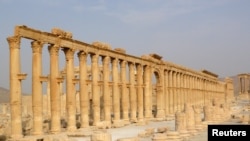The destruction of cultural heritage is a form of cultural warfare and a violation of human rights, says a special U.N. investigator on cultural rights. A report to be submitted to the U.N. Human Rights Council this week documents attacks against cultural and religious sites in global conflicts.
In 2001, the Taliban in Afghanistan destroyed the colossal Buddhas of Bamiyan statues. In 2012, Islamists destroyed eight mausoleums and ancient manuscripts in Timbuktu, northern Mali. More recently, the world has been witness to the destruction of precious ancient cultural sites in Palmyra, Syria.
The new special investigator on cultural rights, Karima Bennoune, says armed groups in conflict destroy cultural sites for a variety of reasons. She says they use this as a strategy to destroy the morale of a population or as part of an extremist campaign against cultural rights and freedom of religion or as a means of terrorizing a population.
War crimes
She tells VOA the deliberate destruction of cultural heritage as seen in the Syrian conflict can rise to the level of war crimes. She says it could also rise to the level of a crime against humanity when the destruction is systematically targeted against certain population groups.
“Increasingly, people are also looking to certain acts of cultural destruction targeting particular groups as warning signs for other mass atrocities and even as a sort of a part of accompanying genocide - acts of genocide or as preludes to genocide,” said Bennoune.
Bennoune says she agrees that such heinous acts need to be publicized in order to fight them. She also says care must be taken not to give terrorists the publicity they crave by making such destruction attractive.
“I do think it is very important, for example, to look at images of sites that have been destroyed, but I caution against the repeated showing, over and over again until people become almost immune to it, of the actual acts of destruction at the time, which reduces it to a kind of video game,” said Bennoune.
Bennoune says the last thing anyone wants is to do the publicity work for terrorists who are seeking precisely that.





